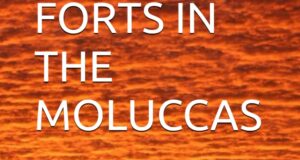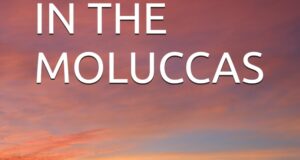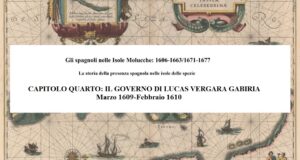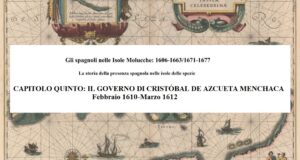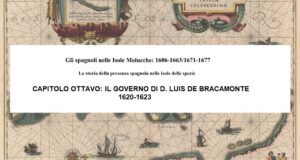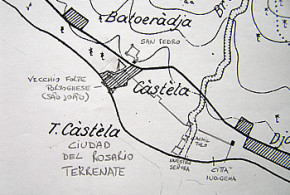This post is also available in:
![]() Português
Português
Written by Marco Ramerini. English text revision by Dietrich Köster.
The Portuguese fort of Ternate was founded by António de Brito in 1522, the foundation stone of the fortress was laid the day of the feast of St. John the Baptist, June 24, 1522, the fort was named “São João Bautista de Ternate.” The outer wall of the fortress enclosing a space of 26 or 27 Portuguese square fathoms, the wall measured 1 arm of thickness and the tower of the fort measured 5 fathoms or 40 palms and was a two-storey building. 1 The fortress was built by the Portuguese on the spot, where the principal city of the Sultanate of Ternate (south-west of the island) used to be, a league from the island’s main port, called Talangame, where the ships anchored. 2
This is the description of the construction of the fort made by Gaspar Correia: “…mandou o capitão abrir os alicerces, e elle com toda a gente, sendo dia do bemauenturado são João Bautista, vinte e cinco (The day is June 24) dias de julho de 522, foi dita sua missa solene, festejada com muita artilharia dos navios,...” “E foi a primeira huma torre quadrada afastada do mar um jogo de bola, e de ahy correo o muro atrauessando pera a terra espaço de trinta braças, de onde tornou a voltar, fazendo quadra, outras trinta braças, em que se fez outra tal torre, e de ahy voltou à praia, onde fez outro canto, e correu o muro ao longo da praia a çarrar (=encerrar) na primeyra torre, junto da qual fiqou a porta de longo da praia, com sua gorita (=guarita). Assy (=assim) que a obra se foy fazendo com estas duas torres sómente, que depois nas quinas das quadras se fizeram outras taes torres, e no meo (=meio) se fez a torre da menagem grande, e no primeiro sobrado varandas para todas partes, e no sobrado de cyma suas guaritas, e fortemente madeirado, d’onde podiam tirar falcões;… ” 3
In 1526 three years after the work started António de Brito gave the command of the fortress of Ternate to Garcia Henriques. The work of the fortress was far from being complete, in fact Castanheda informs us that on the side that looked at the sea the wall had not yet been completed, while on the side which faced the mountain only two ramparts were built, one only 2 fathoms high and the other “não tinha feyto mais que os alicerces“. The tower “da managê” was high “xl palmos cõ dous sobrados, & do derradeyro até ho telhado sem paredes se não cõ caniçadas de canas fédidas forradas desteiras, & disto erão feytos os repartimentos das camaras“, also of the same material of the walls were made the Feitoria, where owing to the incompleteness of the work the pigs and goats could move freely. 4
In 1537 at the time of the Portuguese Governor António Galvão the city of Ternate had a population of 123 Portuguese and with their wives, their children, their slaves and servants the total number reached 1,600 people. 5 In front of the Portuguese fort was a coral reef, which made it difficult to accede the ships. It had three passes, the first was called “Lymatao“, it was located to the south at the end of the town “dos mouros”, the channel in the center was called “barra d’arvore“, because it was located in front of a high tree and the last channel called “barra da Nossa Senhora“, located at the eastern end of the Portuguese city, about 200 fathoms (about 440 m.) from the fort in front of the chapel dedicated to “Santa Maria“. During the government of António Galvão the Central and Southern channels were closed with stones, whereas the “barra da Nossa Senhora” was made more navigable, measuring two fathoms (4.40 m.) in depth. 6
In 1537 Galvão began the construction around the Portuguese city of walls, mud walls, moats and ramparts. The Feitoria was surrounded by mud walls, and inside were also built some warehouses to store the cloves. It was founded a “Casa da Misericórdia“, a water mill, which received water from three leagues away (between 12 km and 18 km) through pipes. Finally a feeble attempt was made to cultivate rice, vegetables and cereals, in the area around the town the breeding was also started and finally a small school for the children of prominent indigenous people and the Portuguese was founded. 7
Another interesting description of the Portuguese fort and the city is given by the “Livro das cidades e fortalezas que a coroa de Portugal tem nas partes da Índia …” written in 1582: the fortress was situated south of the city of the Sultan, along the sea, to a “tiro de espera” from the city “dos Mouros“, the conformation of the land between the fortress and the indigenous city prevented the view between the two. To the south of the fortress was developing a rather large city inhabited by Portuguese casados and indigenous Christians, this was surrounded by a wall “de taipa muito forte“. The harbor in front of the castle is described as a poor port, because the barrier of rock and coral that prevents the larger vessels (“que demandem mais altura que duas braças de agoa“) the passage. Between the mountains and the island fortress on a “outeiro alto“, the Portuguese had built a bastion, where they had placed some pieces of artillery. 8
In 1606 the Spaniards took the control of Ternate; they settled, where the old Portuguese fort used to be.
The Spanish town of Ternate: Ciudad del Rosario.
NOTES:
1 Jacobs, H. “A treatise on the Moluccas (c. 1544)” p. 211
2 Jacobs, H. “A treatise on the Moluccas (c. 1544)” p. 235
3 Gaspar Correia “Lendas da India”, vol. II pp. 714-715
4 Fernão Lopes de Castanheda “História do descobrimento e conquista da Índia pelos portugueses” Livro VI, cap. 128, pp. 358-359. See also: Gaspar Correa “Lendas da India” vol. II p. 996
5 Jacobs, H. “A treatise on the Moluccas (c. 1544)” p. 287
6 Jacobs, H. “A treatise on the Moluccas (c. 1544)” p. 289-291
7 Jacobs, H. “A treatise on the Moluccas (c. 1544)” p. 293-299)
8 “Livro das cidades e fortalezas que a coroa de Portugal tem nas partes da Índia …” foglio 64v. This “outeiro alto” could be the same place where the Spaniards built the Fuerza Nueva fortress.
This post is also available in:
![]() Português
Português
 Colonial Voyage The website dedicated to the Colonial History
Colonial Voyage The website dedicated to the Colonial History


